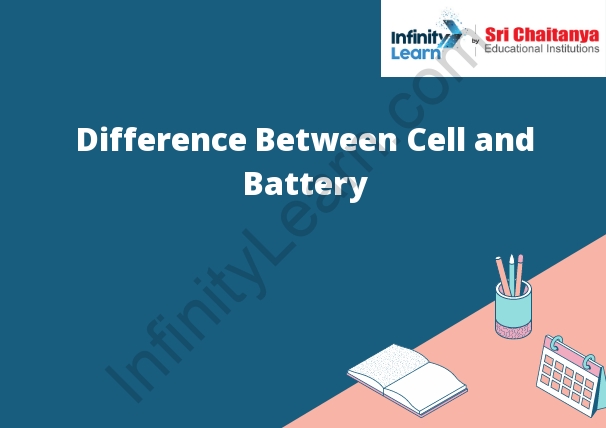Table of Contents
Cell vs Battery
Difference Between Cell and Battery: A battery is a device that converts chemical energy into electrical energy. A battery has two electrodes: an anode and a cathode. The anode is the negative electrode, and the cathode is the positive electrode. The electrolyte is a material that conducts electricity and separates the two electrodes. When the battery is connected to a load, such as a lightbulb, the electrons flow from the anode to the cathode.
A cell is a battery that is divided into two or more parts called cells. Each cell has its own anode, cathode, and electrolyte. When the cells are connected in series, the total voltage is the sum of the individual cell voltages. When the cells are connected in parallel, the total current is the sum of the individual cell currents.

Types of Batteries
- There are a variety of battery types, each with its own advantages and disadvantages. The most common type of battery is the lead-acid battery, which is used in automobiles and other vehicles. Lead-acid batteries are relatively inexpensive and have a long lifespan, but they are bulky and heavy.
- Another common type of battery is the nickel-cadmium battery, which is used in laptop computers and other portable devices. Nickel-cadmium batteries are lighter and more compact than lead-acid batteries, but they have a shorter lifespan and are more expensive.
- Lithium-ion batteries are becoming increasingly common, especially in portable devices. Lithium-ion batteries are lighter and more compact than other types of batteries, and they have a longer lifespan and a higher energy density. However, they are also more expensive.
Secondary Batteries
- A secondary battery is a type of battery that can be recharged by applying an electrical current. Secondary batteries are also called rechargeable batteries.
- There are many different types of secondary batteries, including lead-acid, nickel-cadmium, nickel-metal-hydride, and lithium-ion.
- Lead-acid batteries are the most common type of secondary battery. They are used in cars and trucks, and in portable devices such as cell phones and laptops.
- Nickel-cadmium batteries are used in a variety of applications, including power tools, medical equipment, and portable audio players.
- Nickel-metal-hydride batteries are used in a variety of applications, including hybrid cars, power tools, and home electronics.
- Lithium-ion batteries are used in a variety of applications, including cell phones, laptops, and electric cars.
Types of Cells
There are three types of cells in the body:
- Somatic cells: These are the body’s regular cells, and make up most of the body’s tissues.
- Gamete cells: These are the cells that create sperm and eggs.
- Embryonic cells: These are the cells in the early stages of development, before the baby is born.
Reserve Cells
- In a typical Li-ion battery, the anode is made of graphite, the cathode is made of lithium cobalt oxide (LiCoO2), and the electrolyte is a lithium salt in an organic solvent.
- The anode of a Li-ion battery is made of a graphite compound. During discharge, lithium ions (Li+) are released from the cathode and transported through the electrolyte to the anode. The anode will then absorb the lithium ions, which will create a voltage difference between the anode and the cathode. This voltage difference is what powers the device.
- When the battery is being charged, a current is passed through the battery in the opposite direction, causing the lithium ions to flow back to the cathode. This will create a voltage difference between the cathode and the anode. This voltage difference is what powers the device.
Fuel Cells
- Fuel cells are a type of electrochemical cell that convert the chemical energy from a fuel into electricity. The first fuel cells were developed in the early 1800s, but they were not used commercially until the late 1950s. Fuel cells are now used in a wide variety of applications, including portable electronics, vehicles, and large-scale electricity generation.
- There are several different types of fuel cells, but the most common type is the proton exchange membrane fuel cell (PEMFC). In a PEMFC, the fuel is converted into electricity by reacting with oxygen from the air. The reaction produces water vapor as a byproduct, which is expelled from the cell.
- Fuel cells have several advantages over other types of electricity generation technologies, including high efficiency, low emissions, and long operating life. They are also very versatile, and can be used in a wide variety of applications.
Cell and Battery Difference
- A cell is a single unit of an electrochemical battery. A battery is an assembly of cells.
- Batteries and cells are both electrochemical devices that convert stored chemical energy into electrical energy. The main difference between batteries and cells is that batteries are made up of multiple cells, while cells are not typically combined to form batteries.
- Batteries are often used to power devices such as flashlights, cell phones, and laptop computers. Cells are used in more specialized applications, such as in electric vehicles and in large-scale energy storage systems.
- Batteries are typically composed of multiple cells that are connected in series. In a typical battery, each cell will have a nominal voltage of 1.5 volts. When all of the cells are connected in series, the battery will have a total voltage of 12 volts.
- Cells are not typically combined to form batteries. However, cells can be connected in parallel to increase the current capacity of the device. By connecting cells in parallel, the current capacity of the device can be increased while the voltage remains the same.









